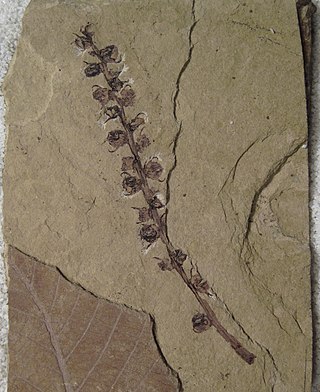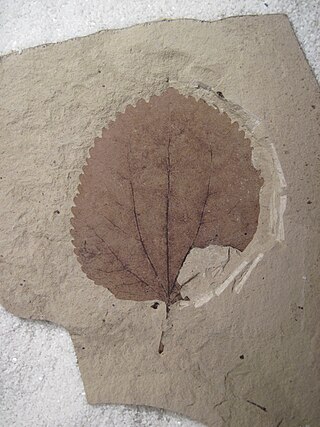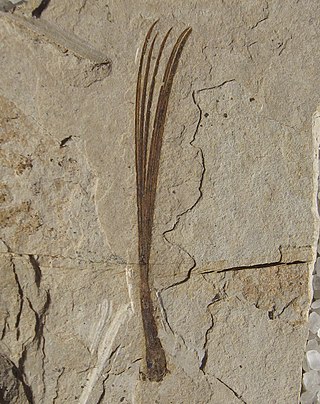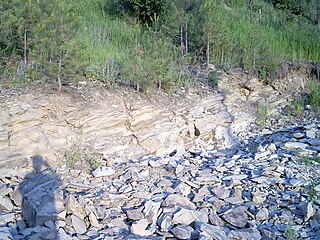
Pseudolarix amabilis is a species of coniferous tree in the pine family Pinaceae. The species is commonly known as golden larch, but being more closely related to Keteleeria, Abies and Cedrus, is not a true larch (Larix). P. amabilis is native to eastern China, occurring in small areas in the mountains of southern Anhui, Zhejiang, Fujian, Jiangxi, Hunan, Hubei and eastern Sichuan, at altitudes of 100–1,500 m (328–4,921 ft). The earliest known occurrences are of compression fossils found in the Ypresian Allenby Formation and mummified fossils found in the Late Eocene Buchanan Lake Formation on Axel Heiberg Island.

Keteleeria is a genus of three species of coniferous trees in the family Pinaceae first described as a genus in 1866.

Pseudolarix is a genus of coniferous trees in the pine family Pinaceae containing three species, the extant Pseudolarix amabilis and the extinct species Pseudolarix japonica and Pseudolarix wehrii. Pseudolarix species are commonly known as golden larch, but are not true larches (Larix) being more closely related to Keteleeria, Abies and Cedrus. P. amabilis is native to eastern China, occurring in small areas in the mountains of southern Anhui, Zhejiang, Fujian, Jiangxi, Hunan, Hubei and eastern Sichuan, at altitudes of 100–1,500 m (328–4,921 ft). P. wehrii is described from fossils dating to the Early Eocene (Ypresian), of Western North America where it is found in the Eocene Okanagan Highlands Allenby and Klondike Mountain Formations. The youngest known occurrence is of mummified fossils found in the Late Eocene Buchanan Lake Formation on Axel Heiberg Island. P. japonica is known from Middle Miocene to Pliocene sediments in Japan and Miocene deposits of Korea. Fossils assigned to Pseudolarix as a genus date possibly as old as the Early Cretaceous Hauterivian stage in Mongolia.

Abietoideae is a subfamily of the conifer family Pinaceae. The name is from the genus Abies (firs), which contains most of the species in the genus. Six genera are currently assigned to this subfamily: Abies, Cedrus, Keteleeria, Nothotsuga, Pseudolarix, and Tsuga.
Paleontology or palaeontology is the study of prehistoric life forms on Earth through the examination of plant and animal fossils. This includes the study of body fossils, tracks (ichnites), burrows, cast-off parts, fossilised feces (coprolites), palynomorphs and chemical residues. Because humans have encountered fossils for millennia, paleontology has a long history both before and after becoming formalized as a science. This article records significant discoveries and events related to paleontology that occurred or were published in the year 1940.

Abies milleri, an extinct species of fir known from fossil remains found in deposits from the early Eocene Ypresian stage in Washington State, USA, is the oldest confirmed record for the fir genus.

The Allenby formation is a sedimentary rock formation in British Columbia which was deposited during the Ypresian stage of the Early Eocene. It consists of conglomerates, sandstones with interbedded shales and coal. The shales contain an abundance of insect, fish and plant fossils known from 1877 and onward, while the Princeton Chert was first indented in the 1950's and is known from anatomically preserved plants.

Pentacentron is an extinct genus of flowering plant in the family Trochodendraceae, consisting of the single species Pentacentron sternhartae. The genus is known from fossil fruits found in the early Eocene deposits of northern Washington state, United States. P. sternhartae are possibly the fruits belonging to the extinct trochodendraceous leaves Tetracentron hopkinsii.

Tetracentron hopkinsii is an extinct species of flowering plant in the family Trochodendraceae. The species is known from fossil leaves found in the early Eocene deposits of northern Washington state, United States and south Central British Columbia. The species was first described from fossil leaves found in the Allenby Formation. T. hopkinsii are possibly the leaves belonging to the extinct trochodendraceous fruits Pentacentron sternhartae.
Paraconcavistylon is an extinct genus of flowering plant in the family Trochodendraceae comprises a single species, Paraconcavistylon wehrii. The genus is known from fossil fruits and leaves found in the early Eocene deposits of northern Washington state, United States, and southern British Columbia, Canada. The species was initially described as a member of the related extinct genus Concavistylon as "Concavistylon" wehrii, but subsequently moved to the new genus Paraconcavistylon in 2020 after additional study.

Taxodium dubium is an extinct species of cypress in the genus Taxodium in the family Cupressaceae which lived from the Late Paleocene to the Pliocene in North America and Europe. The species was first described in 1823 by Kaspar Maria von Sternberg.

Pinus latahensis is an extinct species of conifer in the pine family Pinaceae. The species is known from fossil leaves found in the early Eocene deposits of northern Washington state, United States, and southern British Columbia, Canada.

Carpinus perryae is an extinct species of hornbeam known from fossil fruits found in the Klondike Mountain Formation deposits of northern Washington state, dated to the early Eocene Ypresian stage. Based on described features, C. perryae is the oldest definite species in the genus Carpinus.
The paleoflora of the Eocene Okanagan Highlands includes all plant and fungi fossils preserved in the Eocene Okanagan Highlands Lagerstätten. The highlands are a series of Early Eocene geological formations which span an 1,000 km (620 mi) transect of British Columbia, Canada and Washington state, United States and are known for the diverse and detailed plant fossils which represent an upland temperate ecosystem immediately after the Paleocene-Eocene thermal maximum, and before the increased cooling of the middle and late Eocene to Oligocene. The fossiliferous deposits of the region were noted as early as 1873, with small amounts of systematic work happening in the 1880-90s on British Columbian sites, and 1920-30s for Washington sites. A returned focus and more detailed descriptive work on the Okanagan Highlands sites revived in the 1970's. The noted richness of agricultural plant families in Republic and Princeton floras resulted in the term "Eocene orchards" being used for the paleofloras.

Dipteronia brownii is an extinct species in the soapberry family (Sapindaceae) described in 2001. Fossils of D. brownii are known from stratigraphic formations in North America and Asia ranging in age between Paleocene to Early Oligocene.

Pteronepelys, sometimes known as the winged stranger, is an extinct genus of flowering plant of uncertain affinities, which contains the one species, Pteronepelys wehrii. It is known from isolated fossil seeds found in middle Eocene sediments exposed in north central Oregon and Ypresian-age fossils found in Washington, US.

The Eocene Okanagan Highlands or Eocene Okanogan Highlands are a series of Early Eocene geological formations which span a 1,000 km (620 mi) transect of British Columbia, Canada, and Washington state, United States. Known for a highly diverse and detailed plant and animal paleobiota the paleolake beds as a whole are considered one of the great Canadian Lagerstätten. The paleobiota represented are of an upland subtropical to temperate ecosystem series immediately after the Paleocene–Eocene thermal maximum, and before the increased cooling of the middle and late Eocene to Oligocene. The fossiliferous deposits of the region were noted as early as 1873, with small amounts of systematic work happening in the 1870–1920s on British Columbian sites, and 1920–1930s for Washington sites. Focus and more detailed descriptive work on the Okanagan Highland sites started in the late 1960s.
The Paleobiota of the Klondike Mountain Formation comprises a diverse suite of Early Eocene plants and animals recovered from North Central Washington State. The formation outcrops in locations across the north western area of Ferry County, with major sites in Republic, north west of Curlew Lake, and on the Toroda Creek area. The formation is the southern most of the Eocene Okanagan Highlands, sharing much of the paleoflora and paleofauna with site across Central and southern British Columbia.















